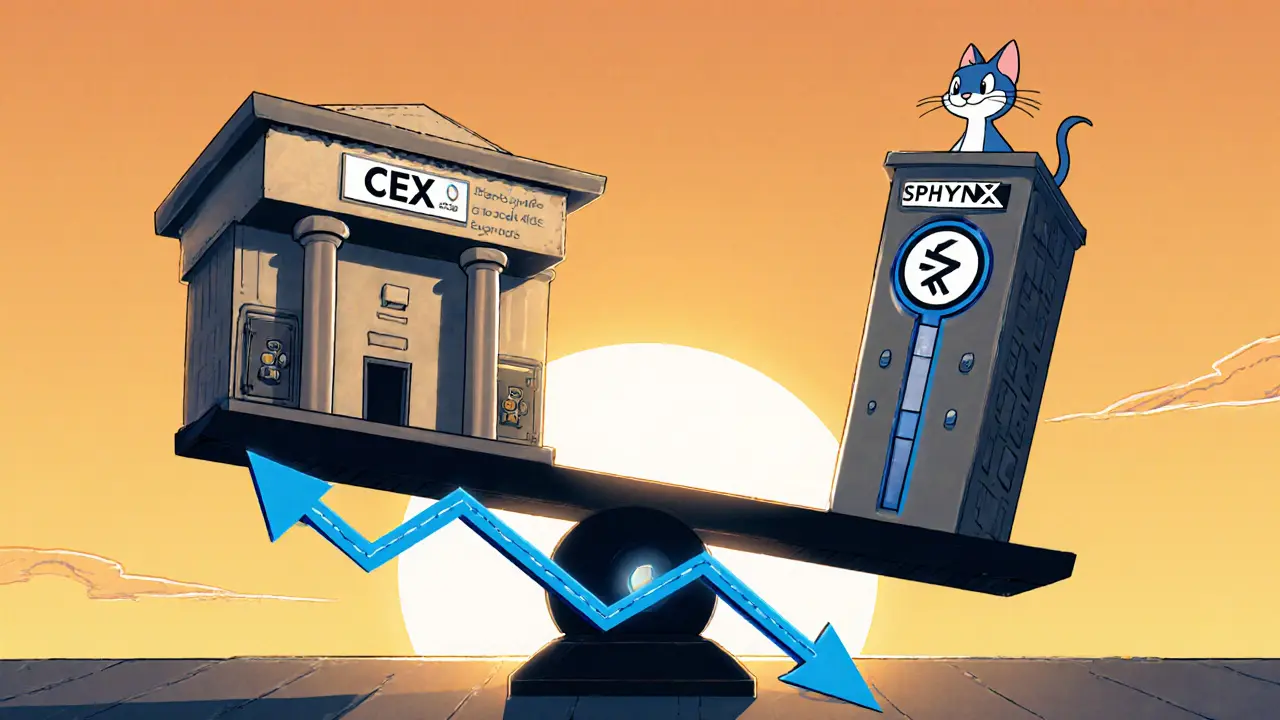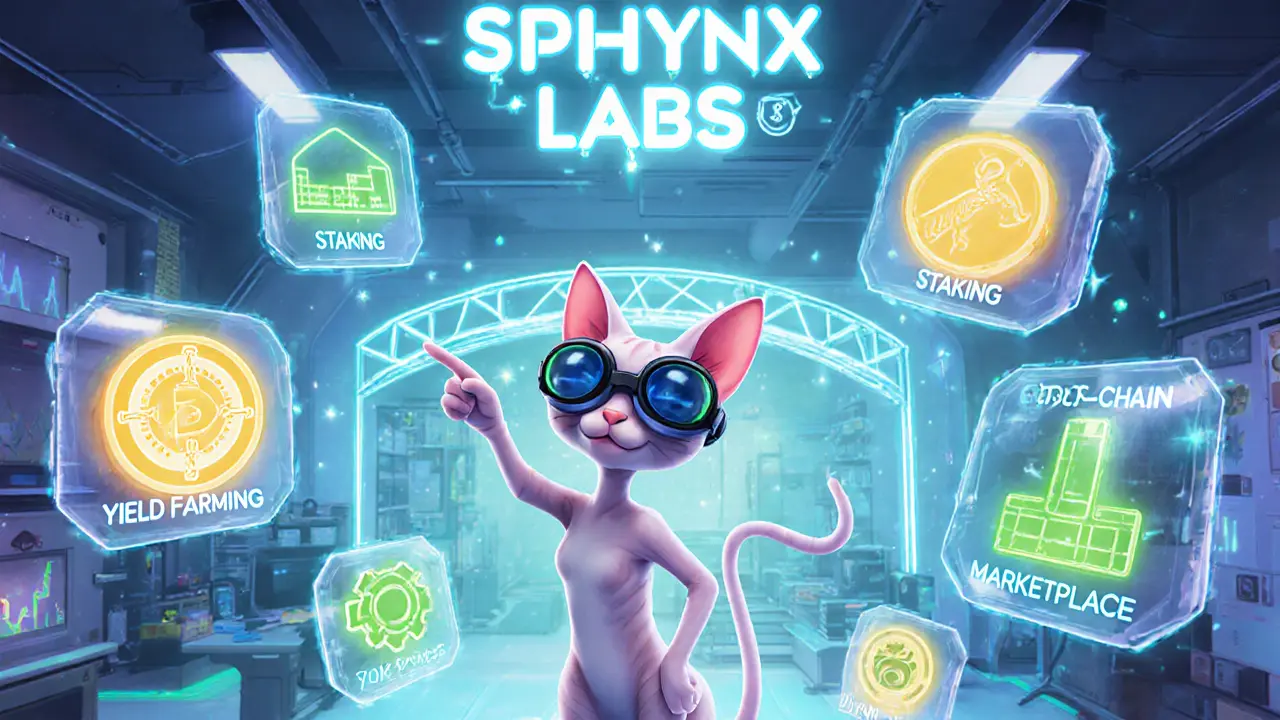SPHYNX Token Value Calculator
SPHYNX Token Value Calculator
Calculate the current USD value of your SPHYNX tokens based on market price ranges.
Sphynx Labs has been buzzing in crypto circles as an all‑in‑one DeFi playground, but does it live up to the hype?
What Sphynx Labs Actually Is
Sphynx Labs is a decentralized finance (DeFi) ecosystem that bundles trading, staking, yield farming, NFT marketplace and cross‑chain bridge services into a single mobile app. Launched in 2023, the platform targets users who want a one‑stop shop without juggling multiple wallets.
The Native Currency: SPHYNX Token
SPHYNX token serves as the native cryptocurrency for the ecosystem, with a hard cap of 1.5 billion tokens. As of 30 September 2025 its market cap sits around $1.13 million, trading between $0.00072 and $0.00089 depending on the exchange.
Feature Set of the Sphynx DeFi App
The app, available on the Google Play Store, boasts a 4.9‑star rating from 1,320 reviews. Its toolbox includes:
- Web3 multi‑blockchain wallet
- Advanced charting with built‑in indicators
- Token swapping (including stop‑loss and limit orders)
- Staking and yield farming modules
- Launchpad for early‑stage projects
- Cross‑chain bridge for asset migration
- Integrated NFT marketplace
Future updates promise on‑chain governance, deeper analytics and a gamified reward layer.
User Experience: Praise and Red Flags
Positive reviewers call the platform an “AIO ecosystem” with a slick UI and smooth navigation. However, criticism focuses on two recurring pain points:
- Unexpected fees on token swaps - some users claim they were charged for swaps that should have been free.
- Occasional lost tokens after a swap, leading to accusations of a scam.
Because DeFi transactions are non‑custodial, the onus is on users to double‑check wallet addresses and fee structures before confirming a trade.
How to Buy SPHYNX - Not a Dedicated Exchange
The token does not trade on a proprietary Sphynx exchange. Instead, you can purchase it on platforms such as Bybit, 3Commas and CoinCodex. Bybit’s process involves a Level 1 KYC, fiat or crypto deposit, then a market or limit order. Trading pairs are typically SPHYNX/USDT or SPHYNX/BTC, with daily volume hovering around $400.
Market Data & Technical Outlook
Technical analysis leans bearish:
- Current price sits below the 50‑day Simple Moving Average ($0.000863) and the 200‑day SMA ($0.000966).
- Relative Strength Index (14‑day) is 48.5, indicating a neutral stance.
- Fear & Greed Index reads 50 - neutral but edging toward fear.
Forecasts from CoinCodex, TradingBeasts and LiteFinance predict a 10‑25 % decline by year‑end, with long‑term averages near $0.00055.
Comparison: Sphynx Labs vs Traditional Centralized Exchanges
| Feature | Sphynx Labs (DeFi) | Typical Centralized Exchange |
|---|---|---|
| Custody | Self‑custody (non‑custodial) | Custodial wallets |
| KYC Requirement | Optional, only for fiat on‑ramp | Mandatory for all users |
| Fee Structure | Variable gas + platform fee | Fixed maker/taker fees |
| Trading Pairs | Limited to tokens supported by the app | Hundreds of pairs |
| Security Model | User‑managed private keys | Exchange holds keys (risk of hacks) |

Pros, Cons & Bottom Line Checklist
- Pros
- All‑in‑one DeFi suite reduces app fatigue.
- Non‑custodial design aligns with privacy‑first ethos.
- Strong community rating on Google Play.
- Cons
- Low liquidity - large orders can swing price.
- Mixed user reports on swap reliability.
- Bearish technical outlook limits short‑term upside.
Final Thoughts
If you’re comfortable navigating DeFi, enjoy experimenting with staking and NFT drops, and can tolerate price swings, Sphynx Labs offers a surprisingly rich toolset for a small‑cap project. For risk‑averse traders who prefer custodial protection and deep liquidity, a traditional exchange may still be the safer bet.
Frequently Asked Questions
Is Sphynx Labs a centralized exchange?
No. It is a DeFi ecosystem that lets users keep control of their private keys while accessing trading, staking and NFT features within one app.
Where can I buy the SPHYNX token?
SPHYNX is listed on Bybit, 3Commas, CoinCodex and other spot marketplaces. You’ll need to create an account, pass any required KYC, then place a market or limit order.
What are the main fees when swapping on the app?
Swaps incur blockchain gas fees plus a small platform fee (usually 0.1‑0.2%). Fees vary by network congestion, so check the fee preview before confirming.
Is my data safe on the Sphynx DeFi App?
The privacy policy states no personal data is stored or shared. Security rests on the user’s private key management; loss of a seed phrase means loss of funds.
What’s the short‑term price outlook for SPHYNX?
Technical indicators suggest a bearish bias, with most forecasts predicting a 10‑25 % drop by the end of 2025. Market sentiment remains neutral, so volatility could surprise both ways.

DeFi AIO platforms are the next‑gen liquidity aggregator 🚀
The design ethos of an all‑in‑one DeFi suite reflects a deeper yearning for financial autonomy, reminding us that tools are extensions of our collective intent. It encourages users to explore staking and NFT drops without the friction of juggling multiple wallets.
If you think the fee surprise is a glitch, think again-Sphynx Labs is cash‑grabbing with hidden gas premiums hidden under the UI. Users keep complaining about "free" swaps only to see a silent 0.2% platform cut. This isn't a bug, it's a revenue model. The docs barely mention it, which feels like a bait‑and‑switch. It's time to call out the lack of transparency.
From a user‑experience standpoint, the slick UI and integrated wallet are definite wins. Having staking, swapping, and NFTs under one roof reduces app fatigue. The 4.9‑star rating reflects genuine community love. Still, the occasional lost token incidents are a red flag worth monitoring.
Yo, the whole "decentralized" claim is a smokescreen. They nuke your funds with hidden fees while pretending to be free. Trust no one, especially not an app that can wipe out tokens on a swap. This is why real freedom lives on self‑custody only.
Technically speaking, the platform’s cross‑chain bridge leverages standard EVM relayers, which keeps transaction latency within acceptable limits. However, liquidity depth remains shallow; moving more than a few thousand dollars can cause noticeable slippage. Users should consider breaking large orders into smaller chunks or using limit orders to mitigate impact.
Look the fees are variable gas fees plus platform fee 0.1‑0.2 percent check before confirming it matters.
Oh great, another “all‑in‑one” solution that promises the moon while delivering a few hiccups. At least the UI looks decent, but you still have to babysit your swaps like a pet hamster.
When you first open the Sphynx Labs app, the onboarding flow feels surprisingly smooth, as if the developers anticipated the typical crypto‑newcomer’s anxieties. The wallet creation wizard walks you through seed phrase backup without bombarding you with jargon, which is a nice touch for onboarding. Once inside, the dashboard aggregates your holdings, staking positions, and NFT assets in a single glance, eliminating the need to toggle between multiple dApps. The built‑in charting tools, while not as feature‑rich as specialized platforms, still provide essential indicators like EMA and RSI, letting you make quick decisions. Swapping tokens is a straightforward process: select the pair, set the amount, and confirm-yet the fee preview can sometimes be misleading, showing lower gas estimates that swell under network congestion. Staking modules offer attractive APYs, but they lock your capital for predefined periods, so you need to weigh the opportunity cost against potential rewards. Yield farming opportunities appear in a carousel, and the UI flags the risk tier, although the “high risk” tags are sometimes vague. The NFT marketplace is integrated nicely, allowing you to list and discover collections without leaving the app, though the discovery algorithm favors higher‑volume projects. Cross‑chain bridging works, but you should double‑check addresses because the bridge UI occasionally defaults to the wrong network, leading to failed transfers. Community support is active on Discord, and the dev team posts weekly updates, giving a sense of transparency that many DeFi projects lack. However, the platform’s limited liquidity means that large trades can cause price slippage, which is a critical consideration for whales. The tokenomics of SPHYNX, with a hard cap of 1.5 billion and a market cap hovering near $1 million, suggest a high inflation risk if new tokens are minted for incentives. Technical analysis points to a bearish bias, as the price sits below both the 50‑day and 200‑day SMAs, and the RSI hovers around the neutral zone. Forecasts from multiple analysts predict a further dip of 10‑25 percent by year‑end, which aligns with the broader market sentiment. In summary, Sphynx Labs offers a compelling suite for the adventurous DeFi user, but you must stay vigilant about fees, slippage, and token volatility.
Esteemed community members, I would like to commend the developers for their diligent effort in integrating multiple DeFi functionalities within a single mobile interface. The architecture demonstrates thoughtful design, and the roadmap outlines ambitious yet attainable milestones. Let us remain optimistic and support continued innovation.
Wow!!! The app’s UI is super clean!!! I love how the staking rewards are displayed in real‑time!!! It really boosts confidence!!!
its ok i guess the app does what it says but u gotta be careful with fees
I feel for anyone who loses tokens on a swap; it’s like watching a friend get ripped apart by a silent shark. The platform should have a safety net, but it seems like they left the door wide open. Users keep blaming themselves, yet the UI design itself creates confusion. If the app truly cared, they'd add clearer warnings. Anyway, if you're brave enough, keep experimenting.
Everyone’s hype is overblown; the bearish trend is obvious and the liquidity won’t improve on its own.
Imagine a world where your wallet, your farm, and your art gallery all live in a single, vibrant garden-Sphynx Labs tries to paint that picture, and while the colors are bright, some petals still need pruning.